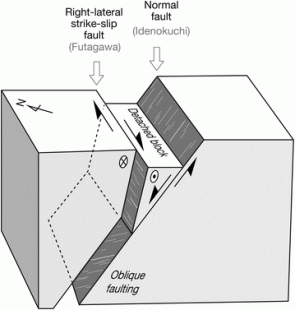- Recommended articles
- January 17, 2017

Together with geodetic and seismic inversions of subsurface fault slip for the 2016 Mw = 7.0 16 April 2016 Kumamoto earthquake, Toda et al. (2016) present a schematic structural model where oblique motion occurred on a northwest-dipping subsurface fault and the slip is partitioned at the surface into strike-slip and normal fault scarps. Their simple dislocation model demonstrates that this bifurcation into pure strike-slip and normal faults likely occurs for optimally oriented failure near the surface. The Kumamoto case, with detailed geological observations and geophysical models, would be the second significant slip-partitioned earthquake around the globe. It provides an important insight into scale- and depth-dependent stress heterogeneity and an implication to a proper estimate of seismic hazard in complex and broad multiple fault strands.


![[Frontier Letter] Recent advances in earthquake seismology using machine learning](https://www.earth-planets-space.org/wp-content/uploads/2024/06/40623_2024_1982_Figa_HTML-80x33.png)
![[Frontier Letter] The theoretical basis for textural indices of eruption dynamics: review and new conceptual models](https://www.earth-planets-space.org/wp-content/uploads/2024/06/40623_2025_2146_Figa_HTML-66x40.png)

